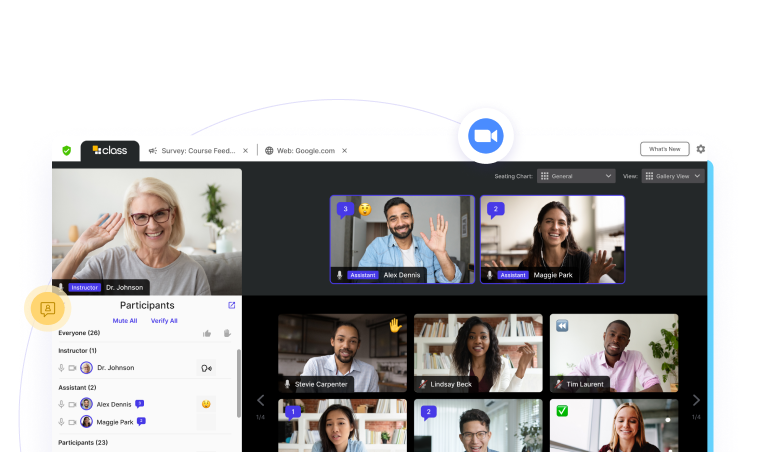
Mike Lovell is the SVP of Marketing at Class. He has dedicated his career to technology and the applications that can innovate the way people live and learn.

Mike Lovell is the SVP of Marketing at Class. He has dedicated his career to technology and the applications that can innovate the way people live and learn.

As virtual instructor-led training (VILT) becomes a cornerstone of how organizations upskill, reskill, advance leaders, and onboard new employees, learning and development (L&D) teams are doubling down on what matters most: measurable outcomes.
One of the biggest insights we uncovered in recent research, conducted in partnership with Training magazine and Microsoft, was how often learner engagement and satisfaction—Kirkpatrick Level One—are used as the primary metric for virtual training success. By far, this was the most common response. It’s clear this is the yardstick many organizations are centering their measurement strategies around.
But if we want to improve training outcomes, we have to go further. Setting goals—and measuring them in real time—are essential to achieving repeatable success. As the old adage goes: if you can’t measure it, you can’t improve it.
Here’s how to approach goal-setting and measurement in ways that elevate your VILT strategy.
Start with measurable goals that are directly aligned with business needs. While this might seem straightforward, it’s critical to make sure your metrics reflect what really matters to the organization, not just what’s easiest to track.
Lorri Freifeld, editor and publisher of Training magazine, puts it well: “Align the training in the beginning with those business unit goals. Decide ahead of time, before you even start creating that training, what behavior change and business outcomes you want to achieve. Work with those business unit leaders, work with your senior leadership to figure out what strategically is the organization trying to achieve and how can training help move the needle on that. Really important conversations to have between L&D and those business unit leaders before, during, and after training.”
While most organizations rely heavily on Kirkpatrick Level One metrics—77% of our survey respondents, in fact—that’s just the beginning. To truly understand training effectiveness, you also need to evaluate behavior changes, knowledge retention, and business outcomes.
As Freifeld notes, “Go beyond those Kirkpatrick Level One and Level Two. It's really great if people love the course. It's really great if they pass the test. But, if they go back to their desk and they keep doing the exact same thing they were doing, you didn't change the behavior fundamentally. And that's really important. You want to make sure that the training adheres and aligns with strategic business goals and business unit goals. And you want to make sure that you're tracking that with those business unit leaders.”
Training should align with business goals and be tracked accordingly. It’s not enough for learners to be satisfied or pass a quiz—you need to see impact.
To move beyond Level One and Two, training must be truly engaging. Yet only 52% of the professionals we surveyed said they use learning analytics to measure engagement, meaning nearly half have a big opportunity in front of them.
Real-time participation data is key. If you notice a drop-off in chat activity, questions, or peer interaction, that’s a signal to adjust your delivery. Maybe that means launching a poll, a quick challenge, or a collaborative activity—anything to re-engage the group.
“If you're seeing a fall-off in the chat, you're seeing a fall-off in questions being asked, you're seeing a fall-off in people interacting with each other…You want to be able to adjust there,” points out Freifeld. “Maybe throw in a challenge, a game that you're going to play, a poll that you want, but you want to make sure that you re-engage folks based on what you're seeing happening.”
Once you’ve set the right objectives, used multiple evaluation levels, and tracked engagement, you’re in a strong position to connect training to performance. That could mean improvements in productivity, compliance, or employee retention.
Freifeld reinforces this notion, adding, “Performance-related metrics are what you want to look at and be able to measure your training against. Obviously not 100 percent of those outcomes are going to be 100 percent attributable to training, but if you don't have a measurement that you're looking to achieve in terms of that business outcome, it's very, very difficult to figure out how effective your training is.”
One organization leading by example is GoHealth. They define clear training goals and integrate multiple evaluation levels to ensure alignment with business priorities. Their programs feature interactive elements—polls, quizzes, breakout rooms, and gamification—that drive deeper engagement.
They’ve also embraced scenario-based learning and live simulations, helping learners apply concepts in real-world settings. As Jay Fortuna, SVP of Talent Operations, shared, expert facilitation is a major part of their success. Instructors are trained to use virtual tools effectively while creating inclusive and collaborative learning environments.
By focusing on clear objectives, deeper evaluation, real-time engagement analytics, and performance-linked outcomes, L&D professionals can unlock meaningful improvements in knowledge retention, behavioral change, and business results.
Let’s keep pushing beyond the basics. Virtual training has incredible potential, but only when we take the time to define success and measure it with intention.
Want to explore this topic further? Check out our full webinar on solving the virtual training paradox, or connect with someone from the Class team to elevate your VILT strategy.

Mike Lovell is the SVP of Marketing at Class. He has dedicated his career to technology and the applications that can innovate the way people live and learn.

Mike Lovell is the SVP of Marketing at Class. He has dedicated his career to technology and the applications that can innovate the way people live and learn.
Get our insights, tips, and best practices delivered to your inbox

Sign up for a product demo today to learn how Class’s virtual classroom powers digital transformation at your organization.

Features
Products
Integrations